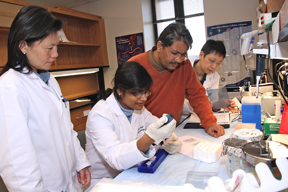 |
| Professsor Mohammed Athar, standing, and research associates Zhiping Weng and Tripti Singh and postdoctoral fellow Jian-He Wu work on a skin cream they believe may help the body defend against and repair damage to skin cells that cause cancer. |
A skin cream developed and tested by UAB Professor Mohammad Athar, Ph.D., has shown it can hyper-activate the body's natural DNA repair mechanisms in preclinical testing, scoring a major breakthrough in the fight against skin cancer.
The active component of the cream protected mice from skin cancer and reduced the growth of cancers already present by repairing damaged proteins called p53, a tumor-suppressor gene. The cream could one day be added to sunscreen as a cancer-fighting ingredient if it is shown to have the same effect in humans. The compound also could be effective in the fight against other cancers that feature p53 mutations.
"This is a very big breakthrough," says Athar, principal investigator of the National Cancer Institute-funded project. "More than 50 percent of all human malignancies have detectable p53 mutations, and the remaining 50 percent that retain wild-type p53 also have problems with other downstream signaling molecules. This finding could potentially help a wide variety of cancers with p53 mutations."
Athar's findings recently were published in the Journal of Clinical Investigation.
Common cancer
More than 1 million cases of non-melanoma skin cancer diagnosed yearly in the United States are considered to be sun-related, according to the American Cancer Society. Non-melanoma skin cancer, the most common type of cancer affecting humans, occurs in either basal cells or squamous cells. Those cancers typically occur in sun-exposed areas.
Most skin cancers are caused by ultraviolet (UV) light exposure to the skin by sunlight or man-made tanning lamps. There is strong epidemiologic evidence supporting a relationship between UV light exposure and non-melanoma skin cancer and a growing evidence of a relationship between indoor tanning and melanoma.
Chronic exposure to UV light is a risk factor for skin cancer in which signature mutations in the p53 tumor-suppressor gene occur. This happens due to DNA damage and contributes to cancer development.
The active component of the cream reactivates disabled forms of the tumor-suppressing p53 protein, enabling it to repair damaged DNA. P53 controls other important cellular functions, including cell division and a genetically encoded auto-destruct pathway called apoptosis that kills unhealthy cells.
"This is the first time someone has shown this can work in relevant mouse models," he says. "We've been working on this for about five years, and we've slowly found we could make the p53 functional again." Athar's colleagues around the country say the findings are encouraging.
"Mutant p53 is an important target for cancer-therapy development because mutations in this guardian of the genome lead to tumor development and progression and are associated with poor response to therapy," says Wafik El-Deiry, a cancer biologist at the University of Pennsylvania School of Medicine in Philadelphia. "These studies have important implications for chemoprevention as well as therapy of common, mutant p53-driven tumors."
Next step
Athar says the next step for the skin cream is beginning Phase I and II clinical trials here at UAB. When those begin "depends on funding," he says. Athar hopes to pursue the compound's use in other cancers with p53 mutations, especially pancreatic and breast cancers — two of the common forms of cancer with frequent p53 mutations.
"The most important part of this finding is that if this proves correct, it will open doors for a large number of clinical trials for cancers in which we have identified p53 mutations," he says. "I'm certainly interested in investigating how this compound can work in treating other cancers."